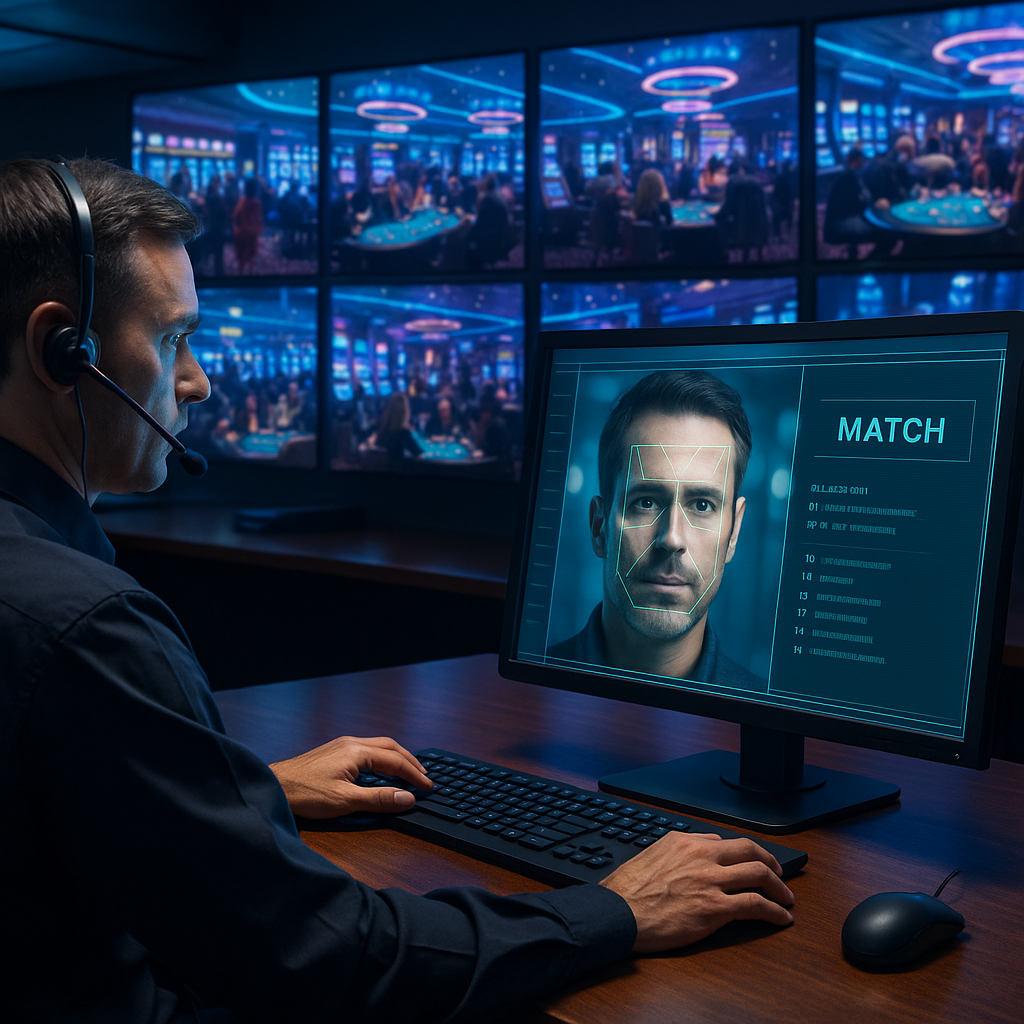In 2025, the casino experience looks more futuristic than ever before, and at the heart of it is a powerful innovation: casino facial recognition technology. No longer a niche security tool, facial recognition has evolved into a fundamental piece of the modern casino ecosystem, quietly changing how guests are monitored, protected, and even rewarded.
But how does casino facial recognition technology work? And why are so many casinos investing heavily in it? Let’s dive deep into this high-tech world where artificial intelligence, data analytics, and surveillance collide on the casino floor.
The Basics of Casino Facial Recognition Technology
At its core, casino facial recognition technology uses advanced cameras and artificial intelligence algorithms to identify and track individuals based on their facial features. High-definition cameras placed throughout the casino floor capture images of players in real time. Those images are then compared against massive databases containing photos of known individuals—whether they are VIPs, banned players, cheaters, or self-excluded gamblers.
By analyzing key points on a person’s face, such as the distance between the eyes, the width of the nose, and the shape of the jawline, casinos can achieve identification accuracy rates above 95%, even when lighting conditions or angles aren’t perfect.
This technology doesn’t just work for security purposes. In 2025, many casinos are using it to enhance customer experiences, offering personalized service based on the player’s history and preferences.
How Facial Recognition Operates in a Casino Setting
Once a guest enters a casino using casino facial recognition technology, the system quietly begins operating behind the scenes:
- Face Capture: High-res cameras at entrances, gaming floors, VIP lounges, and cashier stations automatically capture facial images.
- Feature Extraction: Sophisticated software maps dozens of facial data points into a unique biometric template.
- Database Comparison: The system compares the facial template against multiple databases, which could include:
- Lists of banned players
- Self-exclusion registries
- High-roller (VIP) customer profiles
- Casino employee rosters
- Real-Time Alerts: If a match is found—whether it’s a known card counter or a prized VIP—the appropriate security or customer service team receives an instant alert.
- Action Execution: Staff can then act accordingly, whether that’s quietly escorting out a banned player or personally greeting a loyal VIP with special treatment.
Thanks to advancements in cloud computing and AI, casino facial recognition technology now operates in real time, with nearly zero noticeable delay between identification and response.
How Often Do People Get Caught by Facial Recognition on the Self-Exclusion List?
One of the most effective uses of casino facial recognition technology is identifying individuals who have placed themselves on self-exclusion lists. These are players who have voluntarily chosen to ban themselves from entering casinos due to gambling addiction, financial hardship, or personal choice. In the past, enforcement of self-exclusion relied largely on human staff remembering faces or cross-checking ID—an unreliable and often flawed system.
In 2025, facial recognition has changed the game entirely.
Today’s advanced systems can scan thousands of faces a day in real time, cross-referencing them with updated databases of self-excluded individuals. Once a match is detected, an alert is immediately sent to security, who can discreetly escort the individual out before they ever reach the tables or machines.
So, how often do these systems catch people? More than you’d think.
In casinos that have fully adopted casino facial recognition technology, industry insiders estimate that over 85% of self-excluded individuals who attempt to re-enter are successfully identified and stopped. That number was under 25% a decade ago when detection relied mostly on ID checks and security memory.
It’s not perfect—people still slip through in rare cases, especially if the database isn’t current or the camera angle is poor—but the hit rate continues to improve with every software update.
Some casinos have gone even further, allowing individuals to self-exclude digitally and upload their photo directly into the system, making enforcement nearly instantaneous. This move has been widely praised by responsible gambling advocates as a proactive way to protect vulnerable players.
In short: if you’re on a self-exclusion list in 2025, there’s a high probability the system will catch you the moment you walk through the door.
Why Casinos Are Investing in Facial Recognition in 2025
Casinos are not just gambling with luck; they’re investing heavily in technology to protect profits and enhance loyalty. Here’s why casino facial recognition technology is booming in 2025:
- Enhanced Security: Identifying known threats before they cause trouble.
- Compliance with Gambling Regulations: Especially around self-excluded individuals or underage gamblers.
- Loss Prevention: Spotting card counters, cheaters, or individuals colluding at tables.
- Customer Personalization: Recognizing VIPs instantly and offering tailored experiences.
- Operational Efficiency: Reducing the manpower needed for manual surveillance.
In short, facial recognition offers casinos a powerful blend of security and profitability—a rare combination in a high-risk industry.
The Role of Artificial Intelligence in Modern Casino Systems
In 2025, casino facial recognition technology has advanced thanks to deep learning AI models. Early systems in the 2010s could be fooled by changes like hats, glasses, or makeup. Today’s AI-driven solutions adjust for aging, changing hairstyles, and even moderate facial expressions.
AI models can now:
- Predict likely player behavior based on past visits.
- Detect signs of collusion between players.
- Recognize banned individuals despite physical disguises.
- Adapt in real-time, continually refining their matching accuracy.
In many ways, the AI powering casino facial recognition technology is the secret sauce that makes these systems smart, scalable, and incredibly difficult to defeat.
Player Privacy Concerns: Where is the Line?
While casino facial recognition technology offers undeniable advantages, it also raises serious privacy questions. In 2025, players are becoming more aware of how their data is collected, stored, and used.
Casinos typically defend their use of facial recognition by citing security needs and regulatory compliance. However, some gamblers express concerns about:
- How long facial data is stored
- Whether data is shared with third-party vendors
- What happens if systems are breached or hacked
To address these concerns, many jurisdictions now require casinos to:
- Disclose when facial recognition is in use
- Allow players to opt out (though opting out might restrict access to certain areas)
- Adhere to strict data retention and deletion policies
Transparency has become crucial in maintaining public trust, especially as casino facial recognition technology becomes more widespread.
The Link Between Facial Recognition and Loyalty Programs
One of the most exciting (and less controversial) uses of casino facial recognition technology in 2025 is enhancing loyalty rewards programs.
Here’s how it works:
- A guest enrolled in the loyalty program walks onto the casino floor.
- Cameras recognize the guest immediately without requiring a loyalty card.
- Staff can personally greet the guest, offer complimentary drinks, or notify them of personalized promotions.
- Points and perks accumulate automatically based on playtime and behavior—no card swiping needed.
This frictionless VIP experience drives deeper loyalty while offering players a sense of being “seen” and valued, without them lifting a finger.
How Facial Recognition Impacts Game Protection
Beyond identifying card counters, casino facial recognition technology is used in 2025 to monitor for more subtle scams and cheating behaviors.
The system can:
- Spot teams working together at blackjack or poker tables
- Flag abnormal betting patterns combined with player recognition
- Alert management when a known chip thief enters the casino
Combining facial data with behavioral analytics gives casinos an edge they could never fully achieve with human surveillance teams alone.
How AI Powers Modern Casino Facial Recognition Systems
In 2025, artificial intelligence is the true brain behind casino facial recognition technology. While cameras handle the visual input, it’s AI that makes sense of it all—analyzing, comparing, predicting, and learning from massive amounts of facial data in real time. Without AI, facial recognition would be clunky, slow, and easy to fool. But with it? Casinos now have one of the most accurate and efficient surveillance tools ever developed.
Here’s how AI elevates facial recognition to a whole new level on the casino floor:
1. Real-Time Facial Mapping
AI-powered software breaks down a guest’s face into a unique biometric signature—mapping over 60+ facial landmarks such as eye spacing, nose width, jaw shape, and even subtle asymmetries. This all happens in milliseconds, even as people are moving, talking, or glancing away.
The latest AI models can compensate for:
- Aging
- Facial hair changes
- Makeup or glasses
- Partial obstructions like hats or masks
- Different lighting or camera angles
Without AI, these variables would throw off older systems. Today, the tech is agile enough to keep up with the natural variety in human appearance.
2. Pattern Recognition and Behavioral Learning
The AI behind casino facial recognition technology doesn’t just recognize faces—it learns from them.
It can detect patterns in player behavior, such as:
- Repeated table visits
- Entry/exit patterns
- Suspicious pauses near cashier windows
- Unusual bet sizing relative to previous sessions
This gives casinos a powerful tool to spot cheaters, advantage players, or even guests displaying signs of distress or gambling addiction.
3. Cross-Referencing Massive Databases
AI can compare incoming facial data to multiple databases simultaneously, including:
- Known card counters or banned individuals
- Internal loyalty profiles
- Government-provided self-exclusion registries
- Staff or VIP watchlists
Instead of matching one face to one record, AI compares against tens of thousands of profiles instantly—flagging matches with confidence scores and alerting the right departments without delay.
4. Continuous Improvement Through Machine Learning
Unlike older surveillance systems, AI doesn’t remain static. Every new face scanned improves its learning model. The more data it receives, the smarter and more accurate it becomes.
This means:
- Fewer false positives
- Higher match precision
- Constant updates without needing full system overhauls
It’s the definition of “getting better with age,” and casinos benefit from a system that evolves alongside the threats it was built to stop.
5. Emotion and Risk Detection
In 2025, the most cutting-edge AI systems used in casinos go beyond facial structure—they also detect emotion and microexpressions. They can estimate whether a player is calm, anxious, frustrated, or exhibiting tell-tale signs of intoxication or distress.
While still an emerging application, this AI layer helps:
- Spot high-risk behavior
- Provide interventions before things escalate
- Enhance responsible gambling protections
The Future of Casino Facial Recognition Technology
Looking beyond 2025, the future of casino facial recognition technology points toward even more integrated, AI-driven operations. Here are some trends already emerging:
- Emotion Detection: Some systems are beginning to analyze player mood, helping staff identify frustrated players (who may need intervention) or happy guests ready for upselling.
- Wearable Integration: Smart glasses and watches used by casino staff will display real-time facial match alerts discreetly.
- Blockchain Verification: New platforms are experimenting with blockchain-based facial recognition databases to enhance security and transparency.
The casino floor of tomorrow will likely be a seamless mix of physical gambling action and invisible, AI-enhanced oversight.
Is Facial Recognition Good or Bad for the Average Player?
Casino facial recognition technology isn’t going away—in fact, it’s only becoming more embedded in how modern casinos operate. For the average player, this can be both a blessing and a curse.
On the positive side, facial recognition offers better security, personalized service, and faster loyalty rewards. But on the downside, it also means giving up a certain level of anonymity once taken for granted in casinos.
As a player, understanding how casino facial recognition technology works allows you to make informed choices. Whether you embrace it, tolerate it, or seek out casinos that offer opt-out options, one thing’s for sure: in 2025, the casino is always watching—but now, it’s doing it smarter than ever.


